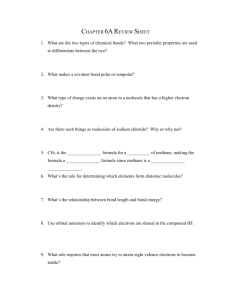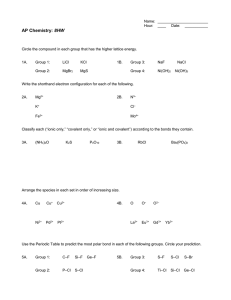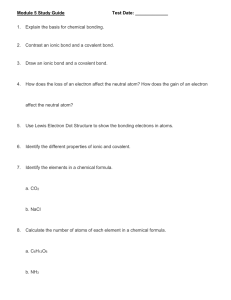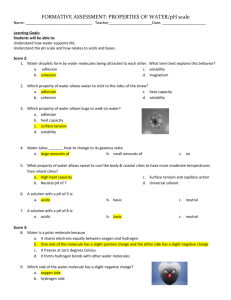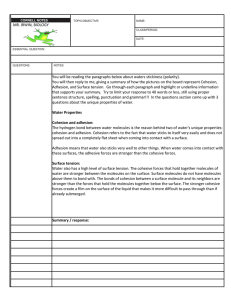02 A inorganic chemistry and water
advertisement
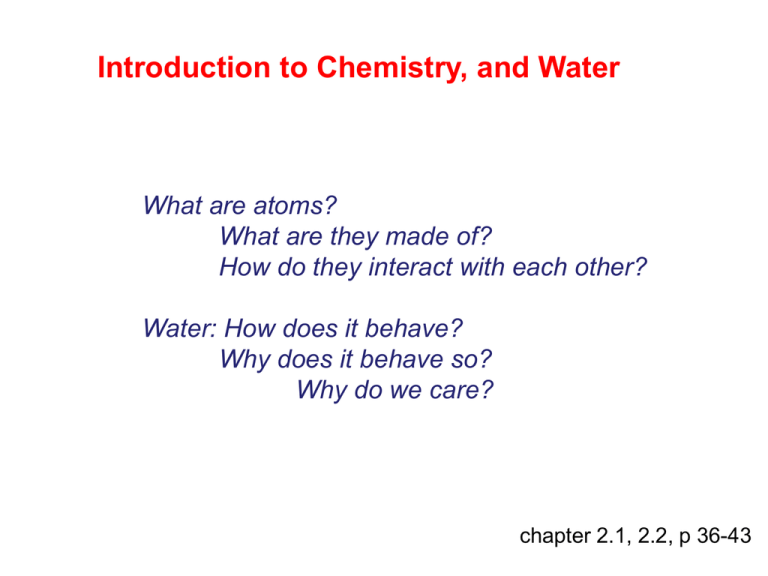
Introduction to Chemistry, and Water What are atoms? What are they made of? How do they interact with each other? Water: How does it behave? Why does it behave so? Why do we care? chapter 2.1, 2.2, p 36-43 Hierarchy of Life Atom, ← Now we will start looking at these. Molecule, ← Organelle, Cell, Tissue, Organ, Organ system, Organism, Population, Community, Ecosystem, Biosphere. chapter DO NOT PANIC This is a pre-assessment. Please work alone. For the elements chosen, name the subatomic particles,* how many of each there are, what charge they have, and what kind of atom you would have if you added one more of each particle.* (You will be handing this in.) <Periodic Table Follows!> * The answers to these parts should be viewed as underlined and emboldened. ELECTRONS This portion of the periodic table shows the electrons, and their respective orbitals. Major elements in living things: - O, C, H, N and P together comprise 97% of your mass. ← notice these trace elements down here. Covalent bonds Two atoms are sharing electrons, in order to establish full, more stable outer orbitals. Ionic bonds: One atom gives up an electron to have its outermost orbital full (resulting in a positive charge), And another gains an electron for the same reason (resulting in a negative ion). As you know, opposites attract…. Emergent properties of compounds: When two or more types of atoms join, the properties of the resultant compound may be entirely unlike those of the initial elements: Below, sodium metal, poisonous chloride gas, and tasty sodium chloride. What others come immediately to mind? Properties of Water Atomic structure: - Covalent bonds. - “Mickey Mouse” model of H2O: slightly positive at the “ears”, and slightly negative at the “chin”. - Water molecules form weak hydrogen bonds due to this polarity…. > adhesion water molecules ‘stick’ to other things > cohesion water molecules ‘stick together’ > thermal properties high specific heat (maritime effect in climate, cooling) > expands on freezing molecules less densely arranged in crystals than in fluid > solubility ‘like dissolves like’, means ionic solutes (salt) and polar solutes (sugar) dissolve in polar solvent (water), and non-polar molecules (lipids) don’t, [but will dissolve or suspend in non-polar solvent (alcohol)]. What is the biologic significance of each of these characteristics of water? ← adhesion cohesion → combine to enable capillary action ↓ Biological Significance (cont.) Many solutes are transported in blood. ← solubility → ↓ Hydrophobic oil in hydrophilic water: Relates to membrane structure… Even things like large proteins can be dissolved. www.daylife.com/photo/08BmgjWfhx5O1 ↑↓ expands on freezing http://www.srh.noaa.gov/images/ama/climate/50Ranges/MarchRanges.JPG Biological Significance (cont.) thermal properties ↑↓ Acids and Bases For our purposes, an acid can form H+ in solution, while a base donates OH-,, to make water. e.g.: 2NaOH + H2SO4 ↔ 2 H2O + Na2SO4 note: the arrow goes both ways… This is an equilibrium reaction. pH The pH scale indicates the relative amount of H+. i.e., in neutral, distilled water, the concentration of dissociated H+ is 10-7 Molar (essentially one in 10-7 water molecules is H+ and OH- ), and the positive of the exponent is the “pH”, or in this case, pH 7. If a base is reacting with those H+, there will be fewer of them, and the pH goes… UP. Think about it. www.rrcc.nsw.gov.au/index.php?page=environmental note: - A high pH is a low H+ concentration. A high pH is a high OH- concentration. e.g. 10-4 [H+] solution has 10-10 [OH-]. - The scale reflects orders of magnitude i.e., pH 3 has 100 times the [H+] as pH 5. Why do we care about acids and bases? 1. pH is an important influence on virtually all of your chemical reactions. e.g., Enzymes only work in a specific pH range. 2. Your blood pH tells your brain to make you breath. 3. Very strong stomach acids break down much of your food, then your intestines need to neutralize the acid. 4. Because pH is such an important part of homeostasis, you have weak acids and bases to buffer your system, generally to pH 6.5 to 7.5. What is an emergent property? Describe the chief emergent property of water, and 5 effects that result therefrom. Compare and contrast: covalent vs. ionic bonds Compare and contrast: base vs. acid Pick an element from a periodic table: Provide the number of each subatomic particle. Predict what type of bond it might form, and with what, and why? Benchmark SC.912.L.18.12 Discuss the special properties of water that contribute to Earth’s sustainability as an environment for life: cohesive behavior ability to moderate temperature, expansion upon freezing, and versatility as a solvent. Enduring Understandings Water is an essential component of life as we know it Essential Questions How does water enable you to survive? element hydrogen bond proton polarity neutron adhesion electron cohesion isotope thermal property ion freezing O (oxygen) solubility C (carbon) capillary action H (hydrogen) solute N (nitrogen) hydrophobic trace element hydrophilic covalent bond acid ionic bond base emergent property equilibrium compound buffer adhesion molecule cohesion covalent bond hydrogen bond acid base pH solubility


